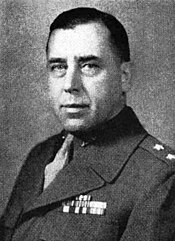Leland Hobbs
| Leland Stanford Hobbs | |
|---|---|
 |
|
| Born | February 4, 1892 Gloucester, Massachusetts, United States |
| Died | March 6, 1966 (aged 74) Walter Reed Army Hospital, Washington, D.C., United States |
| Buried at | Arlington National Cemetery, Virginia, United States |
| Allegiance |
|
| Service/branch |
|
| Years of service | 1915–1953 |
| Rank |
|
| Service number | 0-3809 |
| Unit |
|
| Commands held |
3rd Infantry Regiment 30th Infantry Division III Corps 2nd Armored Division IX Corps |
| Battles/wars |
Pancho Villa Expedition World War I World War II Occupation of Japan |
| Awards |
Army Distinguished Service Medal (2) Silver Star (3) Legion of Merit (2) Bronze Star (3) |
| Other work | Banking executive |
Major General Leland Stanford Hobbs (February 4, 1892 – March 6, 1966) was a decorated senior United States Army officer who commanded the 30th Infantry Division in Western Europe during World War II.
Hobbs was born on February 4, 1892 in Gloucester, Massachusetts and was raised in New Jersey. In 1911 he attended the United States Military Academy (USMA) at West Point, New York. He graduated four years later in June 1915, as part of the West Point class of 1915, also known as "the class the stars fell on", graduating alongside Dwight D. Eisenhower, Omar N. Bradley, James A. Van Fleet, Henry Aurand, Roscoe B. Woodruff, Stafford LeRoy Irwin, John W. Leonard, Charles W. Ryder, Vernon Prichard and Paul J. Mueller. Like Hobbs, all of these men would later become general officers.
He was subsequently commissioned as a second lieutenant in the Infantry Branch of United States Army and was assigned to the 12th Infantry Regiment, then stationed at Nogales, Arizona. He saw there his first action in the skirmishes with the Mexican bandits during the Pancho Villa Expedition.
...
Wikipedia
